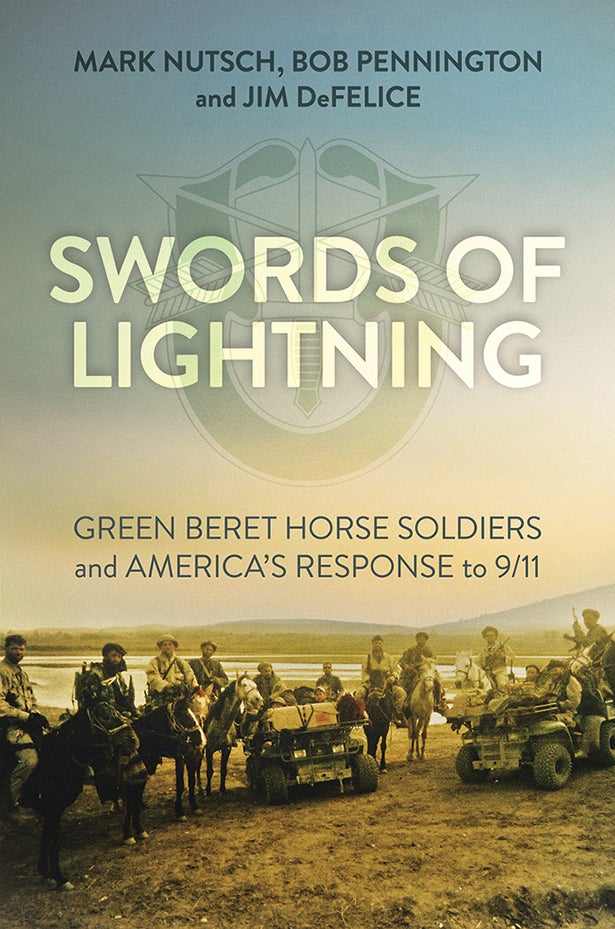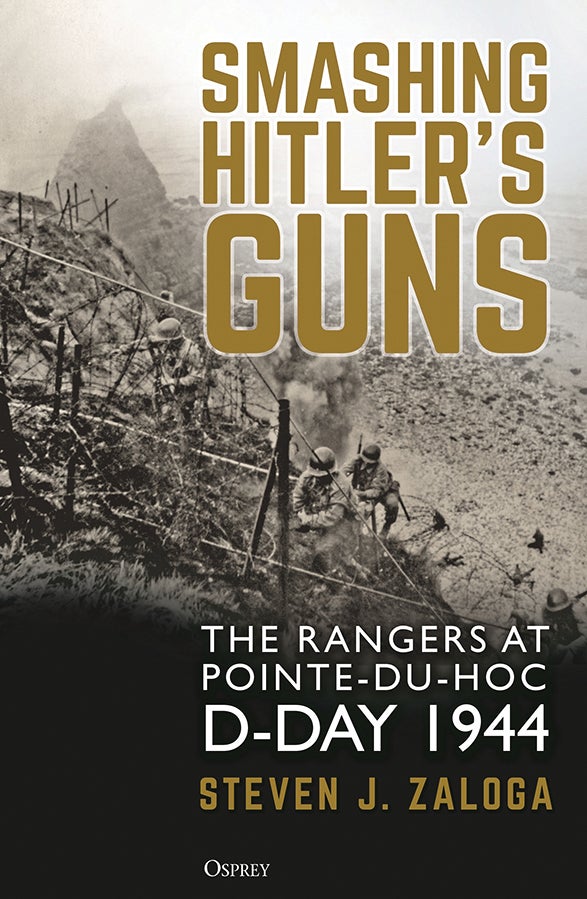A-Team Hits the Ground in Afghanistan

Swords of Lightning: Green Beret Horse Soldiers and America’s Response to 9/11. Mark Nutsch, Bob Pennington and Jim DeFelice. Permuted Press. 352 pages. $28
By Lt. Col. Mark Reardon, U.S. Army retired
Mark Nutsch and Bob Pennington were the commander and deputy commander, respectively, of Special Forces Operational Detachment Alpha 595, the Green Beret A-team that worked with Afghan allies to overthrow the Taliban in the opening campaign of Operation Enduring Freedom.
Their riveting story, told with the help of bestselling author Jim DeFelice, is titled Swords of Lightning: Green Beret Horse Soldiers and America’s Response to 9/11. This superlative book provides a long-overdue and unique perspective of those once-in-a-lifetime experiences.
Swords of Lightning begins conventionally enough with background not only about the team itself, but also about other key individuals of the 5th Special Forces Group (Airborne) based at Fort Campbell, Kentucky. The narrative provides insight into the unexpected transition from peace to war as Operational Detachment Alpha (ODA) 595 scrambles to obtain equipment, information, people and a clear-cut mission before deploying.
Unexpectedly, two detachment members do not accompany their comrades because of a professional schooling obligation. This incident serves notice that the trumpets of war can temporarily subdue, but rarely eliminate, parochialism and bureaucratic influences.
Following its arrival in Uzbekistan several weeks after 9/11, ODA 595 watches Karshi-Khanabad Air Base take shape while awaiting a directive to link up with Northern Alliance fighters near the northern Afghan city of Mazar-i-Sharif. Excitement, concern and fatalism accompany delivery of the detachment’s operational instructions. The 5th Group commander bids an emotional farewell to Nutsch and Pennington, who he does not expect to survive.
The book details the team’s insertion on Oct. 19, 2001, its developing relationship with Uzbek opposition leader Abdul Rashid Dostum and its getting acquainted with rank-and-file indigenous fighters. The clash of cultures between Afghans and Americans proved surprisingly muted, attributable in part to Green Beret training and doctrine, but also because both had experienced grievous loss at the hands of al-Qaida.
Combat narrative abounds, with Nutsch and Pennington detailing the opening engagements that shaped the grueling fight for Tiangi Pass, where success in the face of daunting odds paved the way for Dostum’s seizure of Mazar-i-Sharif.
From that point on, however, 5th Group allowed newly arrived detachments to assume some of the responsibilities previously assigned to ODA 595. While the book covers the Nov. 25, 2001, uprising at Qala-i-Jangi fortress and the near-simultaneous Taliban surrender to Northern Alliance forces at Kunduz, this section of Swords of Lightning relies on second-hand contributions more heavily than preceding chapters.
Military professionals, as well as those with a passing interest, might be inclined to believe a full picture of the 2001 campaign in Afghanistan already exists. Books by generals, organizations and journalists have provided numerous second- or third-hand perspectives of ODA 595’s actions.
However, authoritative first-hand narratives often lag behind due to literary stumbling blocks or personal challenges. A great deal of time frequently elapses before published accounts catch up with events of lasting importance. After reading Swords of Lightning, it is evident that Nutsch and Pennington’s riveting tale has been well worth the wait.
Lt. Col. Mark Reardon, U.S. Army retired, is a professional historian who served 26 years in the military. He is the author of Victory at Mortain: Stopping Hitler’s Panzer Counteroffensive and co-author of a multivolume account of Operation Enduring Freedom, Modern War in an Ancient Land: The United States Army in Afghanistan, 2001–2014. He is working on a full-length account of training and equipping the Iraqi army.
* * *
The Facts of Military Life Just for Women

A Girl’s Guide to Military Service: Selecting Your Specialty, Preparing for Success, Thriving in Military Life. Amanda Huffman. Elva Resa Publishing. 176 pages. $24.95
By Terri Barnes
The opening section of A Girl’s Guide to Military Service by Amanda Huffman is titled “To Join or Not to Join,” and this could easily be the subtitle for the book instead of Selecting Your Specialty, Preparing for Success, Thriving in Military Life.
While Huffman’s book includes some information of interest to women who are already serving, it will be more helpful to young women exploring the pros and cons of joining the military.
Drawing on her six years as an Air Force officer and deployment experiences with an Army unit, Huffman outlines the facts of military life specifically for women. She talks about the benefits and advantages, challenges and sacrifices for both officer and enlisted ranks. She gives readers straight talk about the difficult requirements for service members, such as frequent family separations.
A Girl’s Guide presents an overall positive picture of military service for those who can adapt to its requirements and are willing to work hard.
The book includes guidance on healthy emotions, finding a mentor, military marriage, how pregnancy affects military service and a section on exiting the military. The author is also forthright about the difficulties of being a woman in a predominantly male environment, addressing loneliness, physical challenges and sexual trauma.
Huffman cautions potential military members not to underestimate the likelihood or frequency of deployment, even in a time of relative peace.
“Do not join the military expecting that deployment will not happen because the country you are serving is not at war,” she writes. “Things within the military can change in an instant and there is so much more going on in the world than what ends up on mainstream news.”
For prospective military members, the book includes positive and negative examples of information from military recruiters. These examples are good reminders that while recruiters can be reliable sources of information, their job is to convince people to join the military. Recruiters, the author advises, are only one of many resources to consult when deciding whether to join the military.
Huffman offers good advice and general information on many topics. She has drawn primarily on her own considerable experience, but more input from other military women would have given her book a broader perspective. More research—into other service branches and the enlisted experience—would have offered a deeper well of information for readers to draw from.
For women considering a military career, Huffman covers the basics—choosing a service branch, finding a career field, enlisting or becoming an officer—and explores the ups and downs of each.
Her book is a good starting point, but individual research is advisable before taking any life-changing step.
As Huffman writes: “The military is not right for everyone and being informed before you make such an important decision is wise.”
Terri Barnes is a military spouse, book editor and author of Spouse Calls: Messages From a Military Life, based on her column in Stars and Stripes.
* * *
Rangers Avert Germans at Omaha Beach on D-Day

Smashing Hitler’s Guns: The Rangers at Pointe-du-Hoc, D-Day 1944. Steven Zaloga. Osprey Publishing. 368 pages, $35
By Col. Steve Patarcity, U.S. Army retired
Some stories, despite having been written before, surface again to be retold. That new telling can be redundant or a rehash of a previous attempt, causing the reader to approach the account with trepidation. That’s not the case with Steven Zaloga’s latest offering, Smashing Hitler’s Guns: The Rangers at Pointe-du-Hoc, D-Day 1944.
While the story of the 2nd Ranger Battalion has been immortalized in almost countless books and film, Zaloga’s work is a new rendition that explores other aspects of the unit’s assault on a key position that could have given the Germans a decisive advantage on D-Day.
Zaloga is no stranger to students of military history. As a historian, he has published numerous books and works focusing on the former Soviet Union and Russia, armored warfare and the U.S. Army in World War II. Meticulous research and attention to detail are showcased in his most recent offering.
The 2nd Ranger’s mission to attack the German artillery in place at Pointe du Hoc, France, was one of the most critical actions to ensure the success of Operation Overlord, the Allied invasion of Europe. Five artillery pieces targeted both Omaha and Utah beaches, and could have seriously interdicted or disrupted landings.
Scaling cliffs almost 100 feet high and under fire, Col. James Rudder’s unit of 225 men succeeded in ascending them and taking position, only to discover that the guns had been moved a short distance inland. This necessitated patrols to locate and destroy the guns. After accomplishing this mission, Rudder’s men held out for two days against counterattacks, but at a cost of over 50% casualties.
What makes this book stand out from previous accounts is the author’s logical, methodical detailing of the operation and his research into its little-known aspects. Zaloga focuses not just on the operation itself, but also takes the reader through the formation and training of the Rangers, their training with British commandos, the reconnaissance and bombing campaign of the U.S. Army Air Forces on the objective, and intelligence efforts supporting the operation.
Zaloga includes more information than in previous books on the Rangers at Pointe du Hoc. He provides an analysis of the construction and operation of the German battery’s fortified positions, the threat to the landings from German coastal artillery, a thorough account of the German garrison and a review of the Ranger organization and mission, including the supporting operation of Ranger Force B on Omaha Beach.
The final chapter addresses the controversy of whether the Pointe du Hoc mission was necessary, given that the guns had been moved. Zaloga’s answer is that it was a must-accomplish.
An excellent selection of photographs, diagrams, maps and other data enhances the reader’s clarity and understanding throughout.
While not a quick read, this scholarly recounting of a critical mission of World War II is thoroughly enjoyable. Smashing Hitler’s Guns will contribute to Zaloga’s already noteworthy reputation as an author and historian.
Col. Steve Patarcity, U.S. Army retired, is a civilian strategic planner on the staff of the Office of the Chief of Army Reserve, the Pentagon. He retired in 2010 after 33 years of service in the active Army and the U.S. Army Reserve, which included military police and armor assignments in the U.S., Kuwait and Iraq.
* * *
Big Enemies Require Small-Unit Cohesion

Okinawan Reckoning. H. John Poole. Posterity Press. 328 pages. $14.95
By Lt. Col. Tim Stoy, U.S. Army retired
Okinawan Reckoning is a thorough analysis of the 82-day World War II American campaign on Okinawa that lasted from April to June 1945. It focuses on the tactical level, examining U.S. Army and Marine Corps small-unit actions for lessons learned, lessons to drive current and future infantry training for ground combat against potential enemies in Asia, primarily China and North Korea.
Author H. John Poole posits that China’s People’s Liberation Army and the army of the Democratic People’s Republic of Korea will use tactics, techniques and procedures developed during the Chinese Civil War starting in 1927 and refined in World War II to neutralize U.S. armed forces’ firepower and technological advantages. These methods placed a premium on small units, local initiative, urban and difficult terrain defense, subsurface maneuver and movement, and nonlinear defense—all aspects of what Poole classifies as third-generation warfare.
He further states that the U.S. continues to focus on second-generation warfare, emphasizing attrition, firepower, centralized control of the battlespace and linear positions and formations.
Poole says the hard-won lessons learned at a high price paid by soldiers and Marines on Okinawa were quickly forgotten after the war. The lack of decisive success from Korea onward is said to be the result of the U.S. infantry forgetting the secret of success learned fighting against the Japanese: small-unit proficiency and adaptability.
He describes the Japanese as well trained, well led, highly disciplined and tenacious. Japanese troop dispositions on Okinawa made excellent use of broken terrain, an extensive cave network and subterranean movement to negate the enormous firepower the U.S. could bring to bear. Individual Japanese soldiers, fire teams and squads had the autonomy to conduct necessary movement to maximize effects on attacking Americans and preserve their own force.
Poole shows how during the campaign, U.S. infantry soldiers and small-unit leaders learned to identify and avoid enemy kill zones and ambushes, and to effectively attack reverse slope positions.
Most importantly, they learned how the proper and copious use of hand grenades was critical to survival and combat success. Poole emphasizes that infantry must crawl to avoid the devastating effects of machine-gun fire, but it continues doctrinally to conduct assaults standing up. He also notes that American infantry soldiers today throw only one live hand grenade in their training. This is insufficient training on what Poole considers the most important tool in the infantryman’s toolkit.
The main point of Poole’s excellent analysis is the U.S. military must have properly staffed, well-trained and properly equipped fire teams and squads with effective doctrine, without an overreliance on firepower and with decentralized control, to have any chance of winning a future conflict with China or North Korea.
In his conclusion, he writes, “Most future combat will occur within the narrow confines of urban or otherwise broken terrain. That takes dismounted fireteams with light-infantry techniques. … The days of large-unit formations with totally standard procedures are over.”
Okinawan Reckoning is a must-read for infantry leaders and anyone dedicated to training winning infantry teams.
Lt. Col. Tim Stoy, U.S. Army retired, is a military historian. He served 31 years in the Army as an infantry and foreign area officer.

